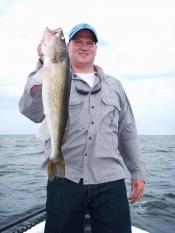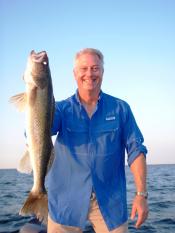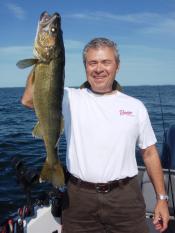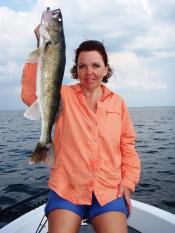 The open water trolling bite is in full swing and many walleyes are being caught by trolling deep diving crankbaits. Last week I was able to get out 4 days and each one was very memorable.
The open water trolling bite is in full swing and many walleyes are being caught by trolling deep diving crankbaits. Last week I was able to get out 4 days and each one was very memorable.
Joining me on Tuesday were three work related clients of mine – Kevin Dotzenrod, Scott RedPath and Chris Holste. I’m the Director of Client Services for an IT and Business Consulting firm and wanted to treat these guys to an open water trolling experience and thank them for their business. Winds were strong (20+ mph) and the rollers out there were big – 3+ feet. Needless to say, it was bumpy out there but nothing that my Skeeter WX2100 couldn’t handle. It’s conditions like this is why I’m in this boat. We battled the waves and fished about 8 hours catching 22 walleyes. I was satisfied with that considering the rough conditions. It’s always a little more challenging maintaining your desired speed. Highlight of the day was when we landed a triple – a 26, another 26 and a 28 incher all at the same time! That was fun!
Thursday evening was beautiful with ideal temps and light winds. Joining my wife and I were some personal friends of ours – John Berg, Bud Berg and Dan Calderon. We got into them pretty good and ended up catching 35 walleyes in about 5 hours. Many fish were in the 25-27 inch range and Tina also caught one over 28 inches. These guys were having a blast out there and many laughs were shared by all. Truly another special memory between long time friends.
 I conducted an open water trolling clinic on Saturday for Mike Worms, Chris Worms and John Noe. I heard from a couple of other open water trollers that the bite was tough on Friday (the day before) due to a mayfly hatch so I was a little concerned I would encounter the same thing on Sat. The water was also flat and it was hot out there which can also make things challenging. My concerns quickly diminished right after we picked up a fat 27 inch walleye within 10 minutes of trolling. The trolling clinic went according to plan and we ended the day catching 35 walleyes with 14 being over the 25 inch mark. These guys were like sponges soaking in all kinds of open water trolling information – asking me really good questions about how to do this and why I do that. It was truly a memorable day being on the water with passionate walleye anglers like myself. That’s what I love about these clinics, I get to meet so many good people and new friendships are formed.
I conducted an open water trolling clinic on Saturday for Mike Worms, Chris Worms and John Noe. I heard from a couple of other open water trollers that the bite was tough on Friday (the day before) due to a mayfly hatch so I was a little concerned I would encounter the same thing on Sat. The water was also flat and it was hot out there which can also make things challenging. My concerns quickly diminished right after we picked up a fat 27 inch walleye within 10 minutes of trolling. The trolling clinic went according to plan and we ended the day catching 35 walleyes with 14 being over the 25 inch mark. These guys were like sponges soaking in all kinds of open water trolling information – asking me really good questions about how to do this and why I do that. It was truly a memorable day being on the water with passionate walleye anglers like myself. That’s what I love about these clinics, I get to meet so many good people and new friendships are formed.
On Sunday I was back at it again, fun fishing with some family and friends. Joining my wife and I were Tina’s Aunt – Beth Hanson and friends John Wainwright and Treas Engelhart. We hit the water at 10am and I went out to where I had ended the night before. After an hour of trolling, we had nothing to show for our efforts. We stuck with it, I made a couple of minor changes lowering the crankbaits in the water column. Shortly after, we really got into them and fish and fish fell into the net. I had a hard time getting 5 lines back out all at once because I was so busy netting fish and taking pictures. We fished about 6 hours and ended up catching 25 walleyes and 8 were over 25 inches. Treas caught another over the slot limit fish of 28 inches (that’s #16 this year for my boat). The majority of those fish were caught between 12 and 2pm. That’s what I love about open water trolling. It can happen at any time and you need to be on the water when it happens and make the most out of the moment.
 I was recently asked “what do you mean by open water trolling”?
I was recently asked “what do you mean by open water trolling”?
That’s a great question and I’ll try and break it down. Most anglers fishing on Mille Lacs are targeting walleyes that are relating to some type of structure (sand or mud flats, gravel reefs, weed edges, transitions, points, etc….). The walleyes are there because that’s where the baitfish (perch, minnows, shiners) like to congregate.
When I refer to open water trolling, I’m not targeting any type of structure and I’m out in the open basin of Mille Lacs trolling deep diving crankbaits and not by any flat. If fact, I avoid the flats. I feel those walleyes have been pressured enough already by other anglers. That doesn’t mean you can’t troll over the top of the flats with crankbaits and catch fish – you certainly can and at times it can be very productive. However, I consider that contour trolling and it’s a different presentation. It’s difficult to run planer boards effectively and keep your crankbaits in the strike zone when the water depth varies. The walleyes out in the open basin are not relating to any type of structure and the reason they’re out there and suspended higher in the water column is because they are feeding on tullibees. I like to say, find the baitfish and you’ll usually find the walleyes. If you find great looking structure but it is void of baitfish, odds are you won’t find the walleyes either.
Keys to our success: It was hot over the weekend with temps in the 90’s and very light winds. These conditions can slow the bite down but there are some little things you can do that may lead to more success. The first thing is to fish deeper areas and look for cooler water temps. Tullibees are very heat sensitive and do not do well in warm water. Try and move your crankbaits down in the water column during those afternoon hours. During mid-day, it’s common to see those arcs on your sonar at 30 feet in 35 feet of water so don’t be afraid to run your crankbaits 3-6 feet from the bottom.
 Another strategy is to get your planer boards out and away from your boat. In these calm conditions, you may be spooking some fish from the shadow of your boat and from your motor noise. I also like to use a trolling motor (mine is an engine mount) versus a kicker. It’s a lot quieter and I call it going into “stealth mode”.
Another strategy is to get your planer boards out and away from your boat. In these calm conditions, you may be spooking some fish from the shadow of your boat and from your motor noise. I also like to use a trolling motor (mine is an engine mount) versus a kicker. It’s a lot quieter and I call it going into “stealth mode”.
With the current hot spell we’re experiencing and as the water temps increase, it’s important that we all pay attention to our catch and release skills. I saw a few floaters out there over the weekend and I always wonder if that angler could have done something different to help that fish survive. Over the years, the number of fish that I’ve killed has been very, very few and my boat has caught hundreds and hundreds of walleyes. Now granted, some may have died after I released them that I don’t know about but the mortality rate has been a very low percentage and certainly lower than what the DNR’s predicted mortality rates.
Try and keep the fish out of the water as little as possible. It sounds trivial but that’s the ultimate goal. Now let’s focus on how you do that.
Be prepared: If you’re going to take a photo of a fish, get your camera ready and make sure you teach the person who’s taking the picture how to use it. Your hook removal equipment (pliers) should also be easily accessible. If you’re going to measure the fish, make sure your measuring tape/board is ready to go and the surface of that measuring stick is cool. I have a stainless steel measuring ruler and it gets really hot if I leave it in the sun. Therefore, I keep it tucked away in the shade and I also like to dip it in the water before I measure the fish. You can actually burn a fish if you’re not careful.
Now you need to secure the fish properly when holding it. The first thing you need to figure out is which hand to use on what side of the walleye. It’s pretty simple – use your right hand on the right side of the fish and your left hand on the left side of the fish. If you use the wrong hand, you will put extra stress on that gill cover and it also makes a very poor photo. Since I’m right handed, I will usually secure the fish with my left hand and remove the hooks with my right – it’s easier for me. Sometimes that is not possible because of the location of the treble hooks. Now slide your index finger and your middle finger between the gill cover and up to the lower jawbone. I then squeeze my thumb down from the outside of the gill cover and against those two fingers. Don’t put all four of your fingers under the gill cover. It’s too much pressure on that fish and you may in fact harm one of the gills. You also don’t want to hold it by only its gill cover. Secure the fish and remove the hooks as quickly and gently as possible.
When returning the fish to the water… I place both hands under the walleye’s belly while pointing it the same direction as I’m trolling. This will allow the water to flow freely through its gills. Do not hold the walleye by its gill cover or around the gill cover. If you do, the walleye will not be able to pass water through its gills on its own. Take your time and when in doubt, do not let go until the walleye swims away on its own. They’re disoriented from being out of the water and it sometimes takes a little time. If they’re struggling, I will grab them by the tail and wiggle them back and forth. This sometimes jumps starts them and they realize they’re free and will quickly swim away. Again, take your time and make sure the walleye is the one calling the shot and not you when it comes to letting go. The last thing you want to do is to release early and then your boat continues to troll away and they belly up being pounded by waves. You also need to have some common sense as well. If you struggled getting the hooks out of the walleye’s mouth and it took some extra time, skip the measure and photo and get that fish back in the water. It’s just not worth killing a fish.
This sounds all easy, but I’ve witnessed time and time again anglers not knowing how to properly secure a walleye and how to release it and that leads to mortality. Another little trick is to turn or lay them upside down when removing the hooks. They have a tendency not to move when you do that.
Now’s the time to get out there and experience the thrill of open water trolling. As always, I’m here to help so feel free to reach out to me. Or let me know if you’re interested in attending one of my open water / on the water trolling clinics and I will send you details.
Until next time – keep trollin’!
More pics from Tuesday, June 26th.
More pics from Thursday evening – June 28th.
Thanks for the great info. Brad! As always, an awesome report!
More pics from Sat – June 30th.
More pics from Sunday – July 1st.
Very nice fish
Unbelieveable, I struggled Friday and you hammerred them. Nice work, you are helping many people have a heck of a lot of fun this year
 . Keep up the great work and awesome reports Brad!!
. Keep up the great work and awesome reports Brad!! 
Which lures/ sizes seem to work the best. Heading up thurs n fri for open basin lead coring and looking forward to a few good days of success.
Thanks
Ace
You’ve pretty much got it nailed down there Brad.
Nice job putting all those people on some very nice fish!
Nice job Brad! I’m glad to see that they are still on the “chew”. I will be taking my sister and her boyfriend out this weekend to teach them some of the techniques that we used.
I just want to thank you again for taking us fishing this weekend. It was a blast! It is very obvious that you have been doing this for a very long time and I am very happy that we could share some of your experience and patience. We all had a great time and I am really anxious to try out some of the training you gave us. We learned a lot and I hope I don’t forget too much.
It is very obvious that you have been doing this for a very long time and I am very happy that we could share some of your experience and patience. We all had a great time and I am really anxious to try out some of the training you gave us. We learned a lot and I hope I don’t forget too much. 
I definitely want to get that Troll-Master for my T-8 after I seen how well it was working for you.
I’m not on the water as much as you are, but I am excited to try out the things you taught us to see if I can produce some nice ones like the ones like the ones we caught on Saturday. Good job!
Brad
Awesome job as usual, puttin the smack down on some GREAT fish.
Wormy, looks like you have been a member for awhile, wanted to say Congrats on the Great fishing, and
Congrats
on your first post.
Looking forward to many more.
Jack
Brad –
Great day on the water Saturday. The information you provided was amazing. I’ve been to a few lead core seminars but didn’t get as much useful information as I did from one day on the water with you. Looks like I’ve got a new fishing technique to add to my book of tricks. It was a pleasure fishing with you and hope to see you on the water soon.
John Noe
Great job and some great pics.
We were targeting big fish and had success with Rapala Deep Tail Dancers TD11 and Storm Deep Thundersticks. Colors varied based on the time of day and sun/clouds. Bright colors were best in low light and anything with chrome was better when the sun came out.
Welcome to IDO Wormie and Zaraspooks! And thank you for attending my open water trolling clinic. It was a pleasure fishing with you guys and Chris too. Now go put that info. to some good use and catch a bunch of open basin walleyes.
And thank you for attending my open water trolling clinic. It was a pleasure fishing with you guys and Chris too. Now go put that info. to some good use and catch a bunch of open basin walleyes.  I’m here to help too!
I’m here to help too!
Brad – curious as to how you are finding the fish out suspended? How do you locate, especially if you are fishing new waters?
When it comes to Mille Lacs, I like to break it down into manageable pieces. Right off the bat, I eliminate two thirds of the lake. Choose a third of the lake that you’ll be fishing – sand on the N/NW end, mud in the NE/Middle or gravel in the south. I believe there are suspended fish in each of these 3 areas of the lake on any given day and none is really better than the other unless there is a distinct but hatch going on. Once you choose the third of the lake you are going to fish, now get out a map.
The next thing I would do is eliminate any water that is under 30 feet deep. Why? Tullibees – the favorite fish that open water walleyes love to target, typically love cooler water and will seek the deepest part of the lake especially as the water temps increase. I’m certainly not saying that you can’t catch walleyes in the shallows during the summer. You can! In fact, I believe there are walleyes that live in the shallows all year long. They primarily feed on baitfish consisting of spottail shiners, mimic shiners and bluntnose minnows and the corkers out there know how to catch them! I also feel there are walleyes that live in the open basin during the entire summer. Their prey consists of tullibees and yellow perch. It’s important you understand why those suspended walleyes are out there and if you find the tullibees, you will eventually find the walleyes.
Now you should have about 1/6 left of the lake to scout – still a daunting task but you can make it even smaller. Determine how you are going to scout that area of the lake. Look at the forecast and in particular the direction of the predicted wind the day you are going to fish. You want your scouting runs to go in the same direction of the wind because it will be easier to navigate and you also want to troll with the wind once you find the suspended walleyes (boat control and planer board control).
Now find a flat for reference point and move out anywhere from ½ to 1 mile away from that flat and mark down a 3 mile scouting run. I typically do not troll within a half mile of any flat. To be honest, I don’t like flats because of the fear of bottoming out my crankbaits. Now move over another mile and mark down another parallel scouting run. Do the same thing again and pencil in your 3rd scouting run. You now you have 3 scouting runs running parallel to each other, each are 3 miles long and you are covering a 6 square mile area. Now mark another 3 mile grid somewhere else on the lake and that should do it. You have 12 square miles of water to scout. If you do that, odds are you will find some suspended fish.
Now you’re on the water and you finally reach the beginning of your first scouting run. Here’s where having a good sonar is a must and equally important, knowing how to use it (even better if your sonar has side imaging capability). Motor 4-5 mph for about a hundred yards and look for suspended baitfish with a few arcs mixed in. You’ll be scouting in depths typically ranging from 30-35 feet of water. The baitfish and arcs will typically be located 15 feet down to 5 feet off the bottom. There may be walleyes even higher in the water column but you probably won’t graph those because of your boat motor noise. You want to find about 6-8 arcs for every 100 yards. If you don’t see anything promising, motor up as fast as you want to go and move down your scouting run about a half of a mile. Motor down again and cover another 100 yards. Repeat until you are at the end of your first scouting run. Now move over one mile to the start of your second trolling run and work your way back the opposite direction. You get the idea… Be precise and methodical. It really doesn’t take that long to eliminate a lot of water. That is your goal – eliminate as much water as you can until you find the right sign. When in doubt – scout!
Hope this helps.
Wow! That’s the best advice on fishing Mille Lacs I’ve ever seen, Brad. I’m looking forward to fishing with you.
Thanks for the info!
Al Case
Has anyone ever met anyone as open with information or as helpful as Brad?
 I haven’t.
I haven’t.
It’s been way too long Brad I’d love to get out fishing again soon.
Very cool… will be trying your technique on Nipigon next week. With as many sows as we catch shallow, there has to be even bigger ones out there suspended that have never seen a lure…
Thanks for the help Brad!
I’m new to this site, and I’d just like to thank y’all for the amazingly useful tips. I’ve been learning leadcore this year, and fishing has been MUCH slower for me than it has been for you. Thanks for the advice…I’ll be trying it out in a few days!
Brad most of the lakes we fish are under 5,000 acres. Can this tactic work on these lakes? Thanks for the help
Yes – open water trolling will also work really well on smaller lakes if you have the right type of forage base within that body of water (tullibees/cisoes, alewives, gizzard shad, perch etc…).
Brad,
Thanks for the help. Our main forage base in our lakes here are gizzard shad. Can’t wait to try some open water trolling this summer.